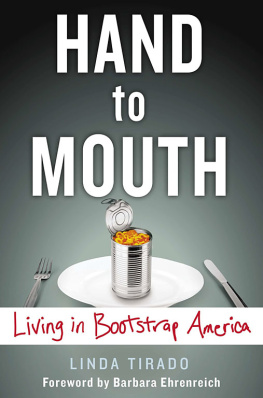Barbara Ehrenreich - Nickel and Dimed: Undercover in Low-Wage USA
Here you can read online Barbara Ehrenreich - Nickel and Dimed: Undercover in Low-Wage USA full text of the book (entire story) in english for free. Download pdf and epub, get meaning, cover and reviews about this ebook. publisher: Unknown, genre: Home and family. Description of the work, (preface) as well as reviews are available. Best literature library LitArk.com created for fans of good reading and offers a wide selection of genres:
Romance novel
Science fiction
Adventure
Detective
Science
History
Home and family
Prose
Art
Politics
Computer
Non-fiction
Religion
Business
Children
Humor
Choose a favorite category and find really read worthwhile books. Enjoy immersion in the world of imagination, feel the emotions of the characters or learn something new for yourself, make an fascinating discovery.
- Book:Nickel and Dimed: Undercover in Low-Wage USA
- Author:
- Publisher:Unknown
- Genre:
- Rating:5 / 5
- Favourites:Add to favourites
- Your mark:
- 100
- 1
- 2
- 3
- 4
- 5
Nickel and Dimed: Undercover in Low-Wage USA: summary, description and annotation
We offer to read an annotation, description, summary or preface (depends on what the author of the book "Nickel and Dimed: Undercover in Low-Wage USA" wrote himself). If you haven't found the necessary information about the book — write in the comments, we will try to find it.
Millions of Americans work full-time, year-round, for poverty level wages. Journalist Barbara Ehrenreich decided to join them in order to find out how anyone survives on six dollars an hour. So began a gruelling, hair-raising and darkly funny odyssey though the underworld of working America.
Nickel and Dimed: Undercover in Low-Wage USA — read online for free the complete book (whole text) full work
Below is the text of the book, divided by pages. System saving the place of the last page read, allows you to conveniently read the book "Nickel and Dimed: Undercover in Low-Wage USA" online for free, without having to search again every time where you left off. Put a bookmark, and you can go to the page where you finished reading at any time.
Font size:
Interval:
Bookmark:
Eighty-one percent of large employers now require preemployment drug testing, up from 21 percent in 1987. Among all employers, the rate of testing is highest in the South. The drug most likely to be detectedmarijuana, which can be detected weeks after useis also the most innocuous, while heroin and cocaine are generally undetectable three days after use. Alcohol, which clears the body within hours after ingestion, is not tested for.
According to the Fair Labor Standards Act, employers are not required to pay tipped employees, such as restaurant servers, more than $2.13 an hour in direct wages. However, if the sum of tips plus $2.13 an hour falls below the minimum wage, or $5.15 an hour, the employer is required to make up the difference. This fact was not mentioned by managers or otherwise publicized at either of the restaurants where I worked.
I could find no statistics on the number of employed people living in cars or vans, but according to a 1997 report of the National Coalition for the Homeless, Myths and Facts about Homelessness, nearly one-fifth of all homeless people (in twenty-nine cities across the nation) are employed in full- or part-time jobs.
In Workers in a Lean World: Unions in the International Economy (Verso, 1997), Kim Moody cites studies finding an increase in stress-related workplace injuries and illness between the mid-1980s and the early 1990s. He argues that rising stress levels reflect a new system of management by stress in which workers in a variety of industries are being squeezed to extract maximum productivity, to the detriment of their health.
Until April 1998, there was no federally mandated right to bathroom breaks. According to Marc Linder and Ingrid Nygaard, authors of Void Where Prohibited: Rest Breaks and the Right to Urinate on Company Time (Cornell University Press, 1997), The right to rest and void at work is not high on the list of social or political causes supported by professional or executive employees, who enjoy personal workplace liberties that millions of factory workers can only dream about... While we were dismayed to discover that workers lacked an acknowledged right to void at work, [the workers] were amazed by outsiders' nave belief that their employers would permit them to perform this basic bodily function when necessary... A factory worker, not allowed a break for six-hour stretches, voided into pads worn inside her uniform; and a kindergarten teacher in a school without aides had to take all twenty children with her to the bathroom and line them up outside the stall door while she voided.
A few weeks after I left, I heard ads on the radio for housekeeping jobs at this hotel at the amazing rate of up to $9 an hour. When I inquired, I found out that the hotel had indeed started paying by the room, and I suspect that Carlie, if she lasted, was still making the equivalent of $6 an hour or quite a bit less.
In 1996 the number of persons holding two or more jobs averaged 7.8 million, or 6.2 percent of the workforce. It was about the same rate for men and for women (6.1 versus 6.2). About two-thirds of multiple jobholders work one job full-time and the other part-time. Only a heroic minority4 percent of men and 2 percent of womenwork two full-time jobs simultaneously (John E Stinson Jr., New Data on Multiple Jobholding Available from the CPS, Monthly Labor Review, March 1997).
On Cape Cod, too, rising rents for apartments and houses are driving the working class into motels, where a room might go for $880 a month in winter but climbs to $1,440 a month in the tourist season. The Cape Cod Times describes families of four living squeezed into one room, cooking in microwaves, and eating on their beds (K. C. Myers, Of Last Resort, Cape Cod Times, June 25, 2000).
Margaret Talbot reports in the New York Times Magazine that personality testing in the workplace is at an all-time high and now supports a $400-milliona-year industry (October 17, 1999, p. 28).
The Bureau of Labor Statistics found full-time private household workers and servants earning a median income of $223 a week in 1998, which is $23 a week below the poverty level for a family of three. For a forty-hour week, our pay at The Maids would amount to $266, or $43 above the poverty level.
Nationwide and even international cleaning services like Merry Maids, Molly Maids, and The Maids International, all of which have arisen since the seventies, now control 20-25 percent of the housecleaning business. In a 1997 article about Merry Maids, Franchise Times reported tersely that category is booming, niche is hot too, as Americans look to outsource work even at home (72 Merry Maids, Franchise Times, December 1997). Not all cleaning services do well, with a high rate of failure among the informal, mom-and-pop services, like the one I applied to by phone that did not even require a cursory interviewall I had to do was show up at seven the next morning. The boom is concentrated among the national and international chainsoutfits like Merry Maids, Molly Maids, Mini Maids, Maid Brigade, and The Maids Internationalall named, curiously enough, to highlight the more antique aspects of the industry, although the maid may occasionally be male. Merry Maids claimed to be growing at 15-20 percent a year in 1996, while spokesmen for Molly Maids and The Maids International each told me in interviews conducted after I left Maine that their firms' sales are growing by 25 percent a year.
The maids' wages, their Social Security taxes, their green cards, backaches, and child care problemsall these are the sole concern of the company, meaning the local franchise owner. If there are complaints on either side, they are addressed to the franchise owner; the customer and the actual workers need never interact. Since the franchise owner is usually a middle-class white person, cleaning services are the ideal solution for anyone still sensitive enough to find the traditional employer-maid relationship morally vexing.
I don't know what proportion of my fellow workers at The Maids in Portland had been on welfare, but the owner of The Maids' franchise in Andover, Massachusetts, told me in a phone interview that half his employees are former welfare recipients and that they are as reliable as anyone else.
When I described the methods employed by The Maids to housecleaning expert Cheryl Mendelson, author of Home Comforts, she was incredulous. A rag moistened with disinfectant will not get a countertop clean, she told me, because most disinfectants are inactivated by contact with organic matteri.e., dirtso their effectiveness declines with each swipe of the rag. What you need is a detergent and hot water, followed by a rinse. As for floors, she judged the amount of water we usedone half of a small bucket, which was never any warmer than room temperatureto be grossly inadequate, and, in fact, the water I wiped around on floors was often an unsavory gray. I also ran The Maids' cleaning methods by Don Aslett, author of numerous books on cleaning techniques and self-styled number one cleaner in America. He was hesitant to criticize The Maids directly, perhaps because he is, or told me he is, a frequent speaker at conventions of cleaning service franchise holders, but he did tell me how he would clean a countertop. First, spray it thoroughly with an all-purpose cleaner, then let it sit for three to four minutes of kill time, and finally wipe dry with a clean cloth. Merely wiping the surface with a damp cloth, he said, just spreads the dirt around. But the point at The Maids, apparently, is not to clean so much as to create the appearance of having been cleaned, not to sanitize but to create a kind of stage setting for family life. And the stage setting Americans seem to prefer is sterile only in the metaphorical sense, like a motel room or the fake interiors in which soap operas and sitcoms take place.
The women I worked with were all white and, with one exception, Anglo, as are the plurality of housecleaners in America, or at least those known to the Bureau of Labor Statistics. Of the private household cleaners and servants it managed to locate in 1998, the BLS reports that 36.8 percent were Hispanic, 15.8 percent black, and 2.7 percent other. However, the association between housecleaning and minority status is well established in the psyches of the white employing class. When my daughter, Rosa, was introduced to the father of a wealthy Harvard classmate, he ventured that she must have been named for a favorite maid. And Audre Lorde reported an experience she had in 1967: I wheel my two-year-old daughter in a shopping cart through a supermarket... and a little white girl riding past in her mother's cart calls out excitedly, 'Oh look, Mommy, a baby maid' (quoted in Mary Romero, Maid in the U.S.A.: Perspectives on Gender [New York: Routledge, 1992], p. 72). But the composition of the household workforce is hardly fixed and has changed with the life chances of the different ethnic groups. In the late nineteenth century, Irish and German immigrants served the urban upper and middle classes, then left for the factories as soon as they could. Black women replaced them, accounting for 60 percent of all domestics in the 1940s, and dominated the field until other occupations began to open up to them. Similarly, West Coast maids were disproportionately Japanese American until that group too found more congenial options (see Phyllis Palmer, Domesticity and Dirt: Housewives and Domestic Servants in the United States, 1920-1945 [Temple University Press, 1989], pp. 12-13). Today, the color of the hand that pushes the sponge varies from region to region: Chicanas in the Southwest, Caribbeans in New York, native Hawaiians in Hawaii, native whites, many of recent rural extraction, in the Midwest and, of course, Maine.
Next pageFont size:
Interval:
Bookmark:
Similar books «Nickel and Dimed: Undercover in Low-Wage USA»
Look at similar books to Nickel and Dimed: Undercover in Low-Wage USA. We have selected literature similar in name and meaning in the hope of providing readers with more options to find new, interesting, not yet read works.
Discussion, reviews of the book Nickel and Dimed: Undercover in Low-Wage USA and just readers' own opinions. Leave your comments, write what you think about the work, its meaning or the main characters. Specify what exactly you liked and what you didn't like, and why you think so.













